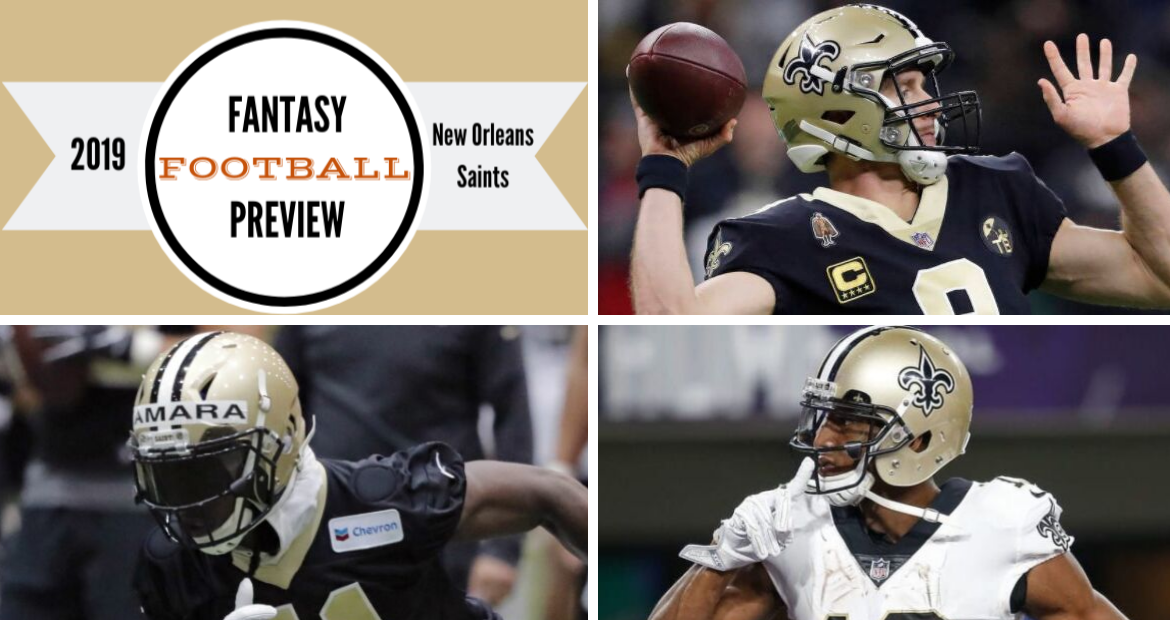
Fitz on Fantasy: 2019 New Orleans Saints Buying Guide
With training camp here, TFG fantasy expert Pat Fitzmaurice is breaking down the prospects for all 32 teams. Click here for a running list of teams, and check back often as teams are added on an almost daily basis. On to the New Orleans Saints…
Fantasy owners are greedy by nature. We’re the Gordon Gekkos of sports fandom. So naturally, Alvin Kamara investors would love to see him in a workhorse role. Even if increased volume meant a dip in Kamara’s extraordinary efficiency, more touches would surely mean more fantasy points. BUT … it’s also nice to have Kamara healthy. He’s played 31 of a possible 31 regular-season games, sitting out last year’s regular-season finale only because the Saints’ playoff position was determined and the outcome of that game was meaningless.
With Mark Ingram suspended for the first four games of 2018, Kamara averaged 29.7 fantasy points per game (half-point PPR), which was 5.0 points per game better than the next-best RB over that period (Todd Gurley). In games Ingram played, Kamara averaged 17.7 points per game. Kamara’s rushing volume didn’t increase significantly during Ingram’s suspension, but Kamara had 35 catches (!) in those four contests, including a 15-catch, 20-target game against the Falcons.
Kamara ranked RB3 in fantasy scoring in 2017, RB4 last year. He’s golden in PPR formats, having caught 81 passes in each of his first two seasons. It doesn’t really matter that he hasn’t had 200 carries in a season and might not get there in 2019. The dude is just so damned efficient. When he averaged 6.1 yards per carry and 10.2 yards per catch as a rookie, we assumed there would be regression. There was. Kamara averaged 4.6 yards per carry and 8.8 yards per catch in his second season, yet he managed to become a more prolific TD scorer. After averaging a TD every 15.5 touches as a rookie, he averaged a TD every 15.3 touches last year and punched in 18 total touchdowns.
Kamara has been the consensus RB4 throughout the offseason, rounding out a Fab Four that also includes Saquon Barkley, Ezekiel Elliott and Christian McCaffrey. Being the Ringo Starr of THAT group isn’t such a bad thing. I suspect most fantasy owners would be thrilled to start their drafts by getting Kamara with the No. 4 pick.
Replacing Ingram as the complementary back in New Orleans is Latavius Murray, now with his third NFL team after stints in Oakland and Minnesota. Murray played a featured role for the Raiders, finishing RB11 in 2015 and RB13 in 2016. He was supposed to be a complementary piece for the Vikings in 2017, but then Dalvin Cook tore his ACL in Week 4, and Murray averaged 17.5 carries and 74.5 rushing yards over the last 10 games of the season. The role Murray played for Minnesota last year was similar to what we should expect him to do for the Saints this year. He averaged 8.8 carries per game and finished RB35.
What makes Murray attractive this year is that he’s been a good TD scorer, and he’s now playing for a team that makes frequent trips to the red zone. As T.J. Hernandez of 4for4.com (@TJHernandez) noted at PlayerProfiler.com, Murray has run for 25 TDs from inside the 10-yard line since 2014, the fifth-highest total among all active backs. Kamara’s presence limits Murray’s yardage ceiling, but if anything happened to Kamara, Murray would become immensely valuable. As it is, Murray has stand-alone value.
Drew Brees is 40 and still one of the best QBs in the game. He had the highest passer rating in the league last year, completing 74.4% of his throws and tossing 32 touchdowns against only five interceptions. But Brees no longer produces the sort of numbers that can melt opponents’ faces off, so you shouldn’t be overpaying for the brand name.
Brees finished QB9 in 2017. He finished QB8 last year – and that was with a career-high four TD runs. He’s still uber-efficient, but the Saints simply aren’t throwing like they once did. They don’t have to. They actually play defense in New Orleans now. The Saints’ front office has been pouring high-quality ingredients into the defensive pot for years and finally produced a tasty gumbo. For years they’d been trying to cook up a decent defense using seaweed and barnacles. Brees had more than 600 pass attempts in every season from 2010 to 2016. The Saints had a bottom-three defense in three of those seasons and a bottom-10 defense in two others. Brees had 536 pass attempts in 2017. He had 489 last year, fewer than 15 other quarterbacks. The Saints have also been playing at a slower offensive pace the last few years. Maybe head coach Sean Payton is simply trying to lengthen the career of his aging quarterback.
An ADP of QB7 isn’t outrageous for Brees, but there isn’t much profit potential at that price. There are better targets from this outrageously deep collection of quarterbacks.
Taysom Hill is still around to annoy fantasy owners by occasionally taking QB snaps inside the 5-yard line, but the true backup to Brees is Teddy Bridgewater. A first-round draft pick in 2014, Bridgewater was once a cause célèbre for Draft Twitter, which never had to formally take an “L” because Bridgewater suffered a devastating knee injury before the 2016 season and no longer carries the burden of high expectations. He’d probably be streamable if anything happened to Brees.
It’s tempting to say “don’t overthink it” with regard to Michael Thomas, who’s been absurdly prolific over his first three seasons, averaging 107 catches, 1,262 yards and 7.7 touchdowns. But we really do need to figure out where Thomas should be slotted in the elite-WR hierarchy since he starts coming into play as an option around the first-round/second-round turn.
Thomas had an NFL-high 125 receptions last year with an 85.6% rate. He’s the NFL catch leader since over the three years he’s been in the league, finishing WR7, WR6 and WR6 in fantasy scoring over that span.
If we’re going to pick nits, Thomas’ average depth of target last season was 7.93 yards, the lowest figure for any WR in the top 25 in receiving yardage. His aDOT was 9.96 yards in 2017, 8.11 yards in 2016. Thomas has a career average of 11.8 yards per catch. The low aDOT and low YPC haven’t been worrisome because of the outrageous target and catch volume. That volume seems secure, but an unforeseen reduction in targets would damage the value of a receiver who doesn’t make a lot of splash plays. Also, Thomas may have limited TD upside simply because he rarely scores from distance – 19 of his 23 career TD catches have come inside the red zone.
Thomas is a machine, but I have four receivers with more big-play upside ranked ahead of him. I’d still be thrilled to get him anywhere outside of the top 15 overall.
Tre’Quan Smith had some fleeting moments of grandeur as a rookie, with 111 yards and two TDs in a Monday-night game against Washington (with one of those TDs giving Drew Brees the all-time record for passing yardage). He also had 10 catches for 157 yards and a touchdown against the Eagles. Smith began producing early in his college career at UCF (a good sign) and was a big-play machine. In his final college season he averaged 19.8 yards per catch and scored 14 TDs. Smith has good speed and ball skills, plus long arms that help him play even bigger than his 6-2, 210-pound frame. Veteran Ted Ginn is standing in his way on the depth chart, but it seems only a matter of time before Smith overtakes him. I really like him as a late-round option.
Ginn might have some value in best-ball leagues, since he still has exceptional speed even at age 34, but it’s hard to get excited about him otherwise. He topped 700 receiving yards in three consecutive seasons from 2015 to 2017 (the first two with the Panthers, the last two with the Saints), and he had a fluky 10-TD year in 2015, but 700 yards and five TDs is probably the ceiling for Ginn now, and he might not come anywhere close to that if Smith takes his starting job.
Cameron Meredith, Rishard Matthews, Keith Kirkwood and Austin Carr are competing for jobs in training camp, but none of them are particularly compelling, even though Matthews and Meredith were briefly well-regarded fantasy assets.
There was a time when it seemed as if Jared Cook was put on this earth solely to frustrate fantasy owners. He was the Loki of tight ends, a mischievous trickster who refused to use his divine powers for good. Cook had always been blessed with an extraordinary combination of size (6-5, 254), speed and athleticism. He would pique our interest with good yardage totals – a 759-yard season for the Titans in 2011, a couple of 600-yard seasons for the Rams in 2013-2014 – but the TD totals always left us wanting more.
Cook finally delivered the goods in his 10th NFL season. He posted career highs across the board with 68 catches for 896 yards and six TDs. He was the leading pass catcher in an Oakland offense that finished 23rd in yardage and 28th in scoring. Cook now goes from a healthy offense to a lethally efficient one. Brees has squeezed fantasy-relevant seasons out of a paddle-handed Coby Fleener (well, sort of) and a geriatric Ben Watson. Brees also made beautiful music with the athletic Jimmy Graham, who had double-digit TD totals in three of his five seasons in New Orleans and crossed the 1,000-yard threshold twice.
If you decide to wait at tight end and let other people sink early-round draft capital into the top-tier TEs, Cook can be a pretty attractive mid-round option.
| PLAYER | FITZ RANK | ECR | ADP | ADVICE |
| Drew Brees | QB12 | QB10 | QB7 | Respect but fade |
| Alvin Kamara | RB4 | RB4 | RB4 | Top four |
| Latavius Murray | RB27 | RB29 | RB36 | Buy |
| Michael Thomas | WR5 | WR5 | WR4 | Second rounder |
| Tre’Quan Smith | WR59 | WR65 | WR59 | Dart throw |
| Jared Cook | TE7 | TE7 | TE8 | Appealing |
ADP = Average Draft Position ECR = Expert Consensus Ranking (based on half-PPR scoring)



